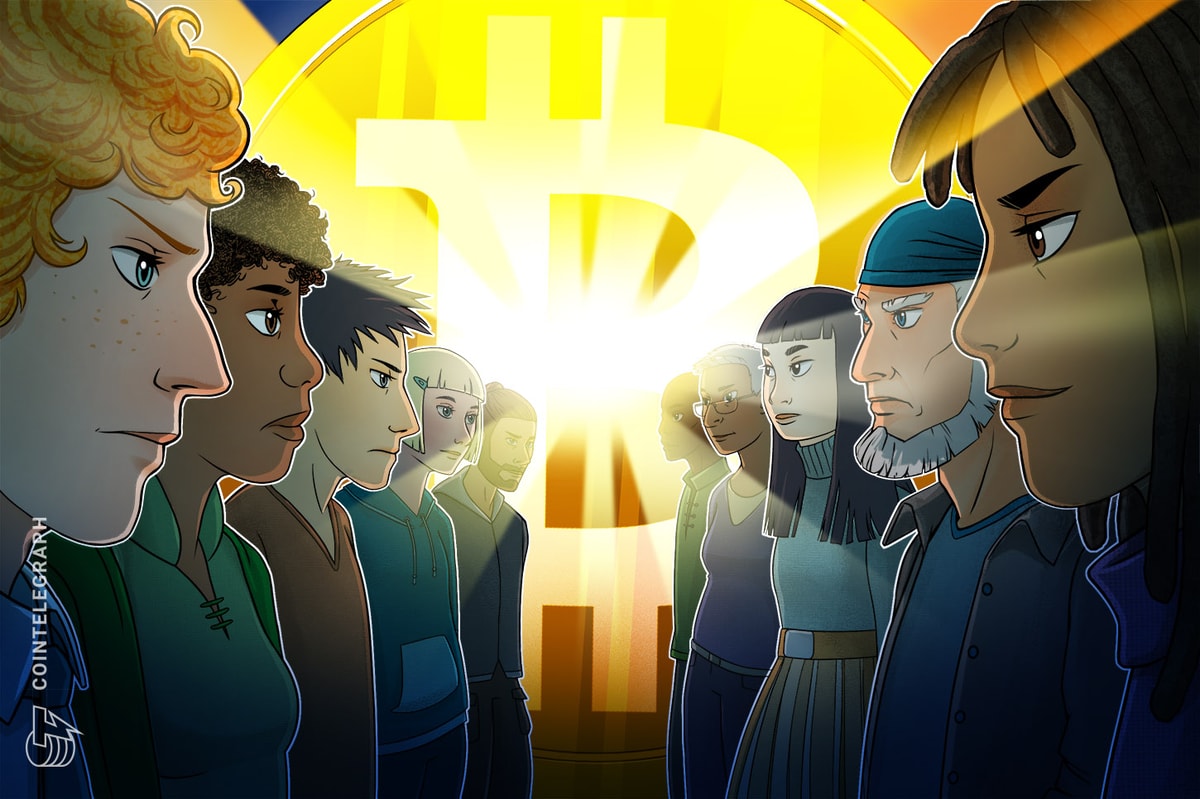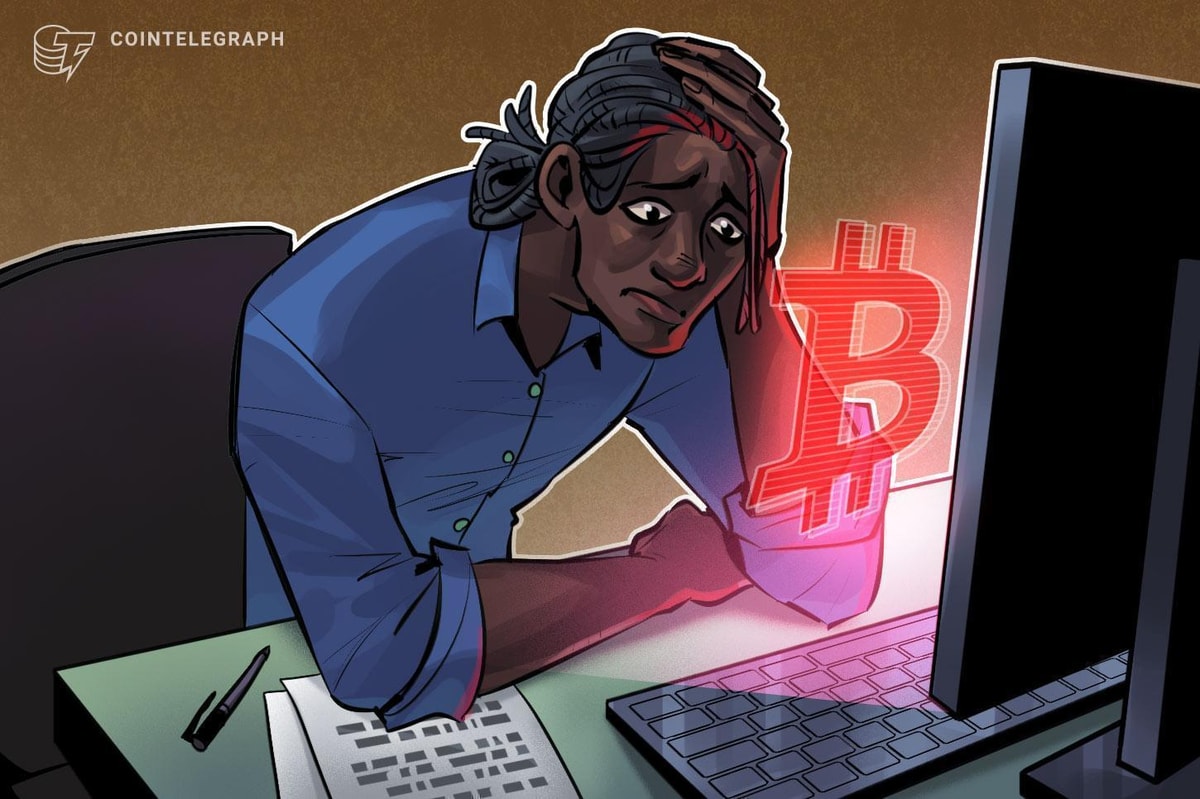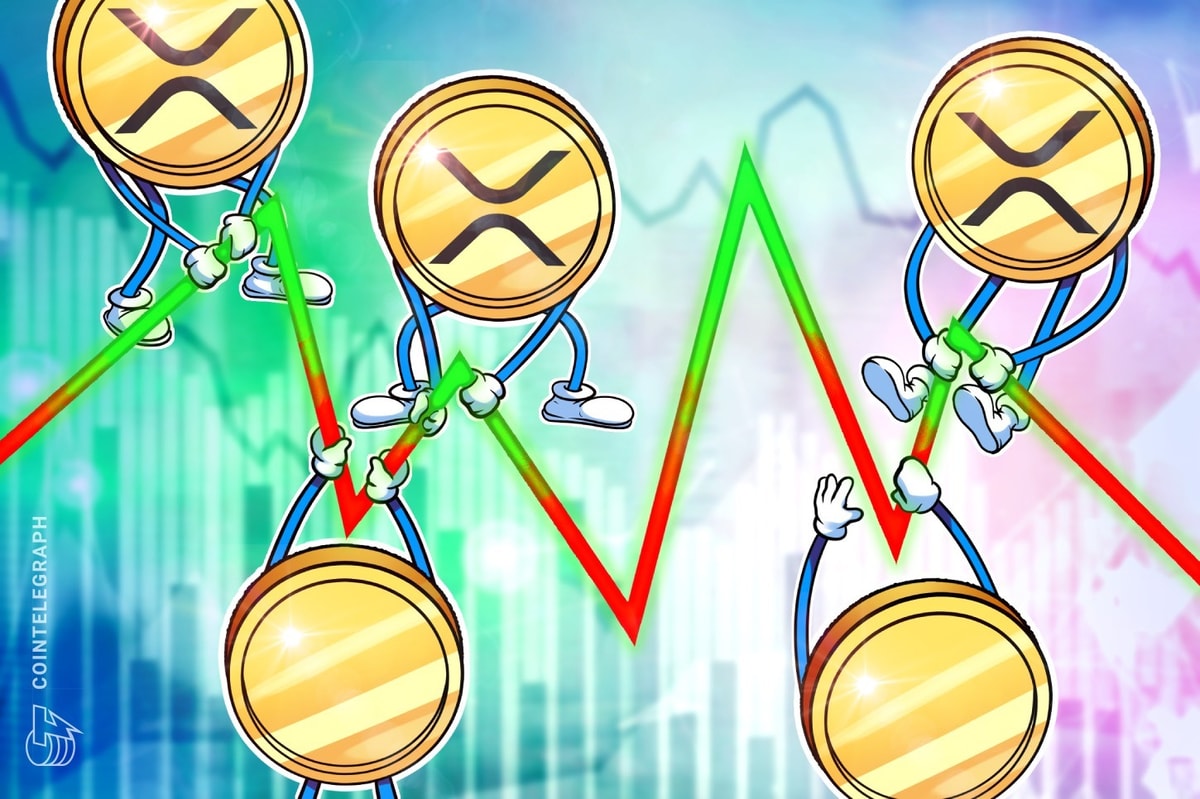Uncategorized
Bitcoin traders are overstating the impact of the US-led tariff war on BTC price
Published
3 days agoon
By
admin
Despite Bitcoin’s 2.2% gains on April 1, BTC (BTC) hasn’t traded above $89,000 since March 7. Even though the recent price weakness is often linked to the escalating US-led global trade war, several factors had already been weighing on investor sentiment long before President Donald Trump announced the tariffs.
Some market participants claimed that Strategy’s $5.25 billion worth of Bitcoin purchases since February is the primary reason BTC has held above the $80,000 support. But, regardless of who has been buying, the reality is that Bitcoin was already showing limited upside before President Trump announced the 10% Chinese import tariffs on Jan. 21.
Gold/USD (left) vs. Bitcoin/USD (right). Source: TradingView / Cointelegraph
The S&P 500 index hit an all-time high on Feb. 19, exactly 30 days after the trade war began, while Bitcoin had repeatedly failed to hold above $100,000 for the previous three months. Although the trade war certainly affected investor risk appetite, strong evidence suggests Bitcoin’s price weakness started well before President Trump took office on Jan. 20.
Spot Bitcoin ETFs inflows, strategic Bitcoin reserve expectations and inflationary trends
Another data point that weakens the relation with tariffs is the spot Bitcoin exchange-traded funds (ETFs), which saw $2.75 billion in net inflows during the three weeks following Jan. 21. By Feb. 18, the US had announced plans to impose tariffs on imports from Canada and Mexico, while the European Union and China had already retaliated. In essence, institutional demand for Bitcoin persisted even as the trade war escalated.
Part of Bitcoin traders’ disappointment after Jan. 21 stems from excessive expectations surrounding President Trump’s campaign promise of a “strategic national Bitcoin stockpile,” mentioned at the Bitcoin Conference in July 2024. As investors grew impatient, their frustration peaked when the actual executive order was issued on March 6.
A key factor behind Bitcoin’s struggle to break above $89,000 is an inflationary trend, reflecting a relatively successful strategy by global central banks. In February, the US Personal Consumption Expenditures (PCE) Price Index rose 2.5% year-over-year, while the eurozone Consumer Price Index (CPI) increased by 2.2% in March.
Investors turn more risk-averse following weak job market data
In the second half of 2022, Bitcoin’s gains were driven by inflation soaring above 5%, suggesting that businesses and families turned to cryptocurrency as a hedge against monetary debasement. However, if inflation remains relatively under control in 2025, lower interest rates would favor real estate and stock markets more directly than Bitcoin, as reduced financing costs boost those sectors.
US CPI inflation (left) vs. US 2-year Treasury yield (right). Source: TradingView
Related: Coinbase sees worst quarter since FTX collapse amid industry bloodbath
The weakening job market also dampens traders’ demand for risk-on assets, including Bitcoin. In February, the US Labor Department reported job openings near a four-year low. Similarly, yields on the US 2-year Treasury fell to a six-month low, with investors accepting a modest 3.88% return for the safety of government-backed instruments. This data suggests a rising choice for risk aversion, which is unfavorable for Bitcoin.
Ultimately, Bitcoin’s price weakness stems from investors’ unrealistic expectations of BTC acquisitions by the US Treasury, declining inflation supporting potential interest rate cuts, and a more risk-averse macroeconomic environment as investors turn to short-term government bonds. While the trade war has had negative effects, Bitcoin was already showing signs of weakness before it began.
This article is for general information purposes and is not intended to be and should not be taken as legal or investment advice. The views, thoughts, and opinions expressed here are the author’s alone and do not necessarily reflect or represent the views and opinions of Cointelegraph.
Toncoin Takes A Hit With 12% Correction After Failing To Break $4.34, More Pain? Bitcoin sentiment falls to 2023 low, but ‘risk on’ environment may emerge to spark BTC price rally Crypto Trader Says Dogecoin Is at a Critical ‘Make-or-Break’ Level, Updates Outlook on Solana and Avalanche Bitcoin Covenants: CHECKSIGFROMSTACK (BIP 348) Illinois State Senator’s Bill Seeks to Claw Back $163 Million Lost to Crypto Fraud Here’s why Bitcoin, altcoins, and the stock market continued falling on Friday Published on By Bitcoin (BTC) sits in one of its least bullish phases since January 2023. According to Bitcoin’s “bull score index,” investor sentiment is showing its lowest reading in two years. Bitcoin bull score index. Source: CryptoQuant CryptoQuant’s “Crypto Weekly Report” newsletter explained that “bull score index” readings that sit below 40 for extended periods increase the likelihood of a bear market. The bull score remained above 40 throughout 2024, only dipping below this threshold in February 2025, as identified in the chart above. However, over the past 24 hours, Bitcoin price has displayed resilience when compared against the massive losses seen in the US stock market. On April 3, Bitcoin closed the day with a green candle, while the S&P 500 was down 4.5%, a historic first. The S&P 500 and Dow Jones extended their decline on April 4, dropping 3.87% and 3.44%, respectively, while Bitcoin held steady near the breakeven point. Related: Arthur Hayes loves tariffs as printed money pain is good for Bitcoin Data from CryptoQuant indicates that Bitcoin’s Value Days Destroyed (VDD) metric currently sits around 0.72, suggesting that Bitcoin price is in a transitional phase. Since 2023, such periods have preceded either price consolidation or renewed accumulation before a bullish breakout. Bitcoin value days destroyed. Source: CryptoQuant The Bitcoin VDD metric tracks the movement of long-term held coins, and it has signaled a notable market trend since late 2024. The metric peaked at 2.27 on Dec. 12, signaling aggressive profit-taking and this dynamic matched the highs seen in 2021 and 2017. However, VDD dropped to 0.65 in April, reflecting a cooling-off period where profit-taking has subsided. This opens the possibility of a “risk-on” market for Bitcoin. In financial terms, a “risk-on” scenario occurs when investors embrace higher-risk assets like cryptocurrencies, often driven by optimism and mean reversions in trends. Amid ongoing market uncertainty that has been fueled by the US-led trade war, Bitcoin could unexpectedly gain from these tense conditions. Speaking on Bitcoin and the crypto market’s potential as a hedge against traditional market volatility, crypto trader Jackis said, “A reminder, this is not a crypto-driven drop but an overall risk-on, tariff, trade war-driven drop. While all of that is unfolding, it seems that crypto has likely undergone most of its downside already and has been lately absorbing all of the selling well.” Similarly, the Crypto Fear & Greed Index also exhibited a “fear” category with a score of 28 on April 4. The index registered an “extreme fear” score of 25 on April 3, suggesting that the current price may present a compelling buying opportunity. Crypto Fear & Greed Index. Source: alternative.me This article does not contain investment advice or recommendations. Every investment and trading move involves risk, and readers should conduct their own research when making a decision. Published on By Opinion by: Merav Ozair, PhD Tech moguls cannot stop heralding the artificial intelligence revolution — from Bill Gates to Sundar Pichai to Jensen Huang — signaling that agentic AI and robotics will claim our jobs and act as our autonomous assistants performing on our behalf in our professional and personal lives. Whether these scenarios happen in a few years or are decades away, we will most likely evolve into that future in some manner, and technology, once again, will reshape our lives. Without the support of blockchain technology, however, it would be quite difficult, and potentially impossible, for agentic AI and robotics to evolve to what its proponents expect them to. If we expect these services and devices to act autonomously, security, privacy, transparency and accountability will be at the top of our minds. These areas are where blockchain shines and can support AI weaknesses to facilitate the scaling and evolution of this vision. Blockchain technology can significantly bolster the security of AI models by leveraging its key features such as decentralization, immutability, traceability, smart contracts, data privacy and identity verification. For example, but not limited to: The decentralization aspect eliminates a single point of attack, increasing the resilience of AI models against breaches. The immutability of blockchain ensures that the data used in training AI models and the models themselves cannot be illicitly altered, maintaining the integrity of the models. Every alteration or decision made by the AI model can be audibly traced through blockchain, providing unparalleled transparency and accountability. Smart contracts automate the enforcement of data access and usage rules, preventing unauthorized or unethical use of AI models. Smart contracts can ensure that data is only used for training and testing and by authorized personnel, locking the option to be used for other purposes. Combining these rules with multiparty computation could prevent or at least mitigate AI adversarial attacks. Blockchain allows secure multiparty computation, ensuring data privacy during AI model training by keeping the data decentralized. Blockchain’s secure identity verification enhances the safety of AI systems by preventing unauthorized access. Integrating AI with blockchain can establish a secure, transparent, traceable and decentralized AI environment, protecting our privacy, enhancing accountability and manifesting responsible AI. AI agents and robotics are programmable. Smart contacts, the driver of digital assets, are programmable. It makes perfect sense that digital assets would be the preferred payment rail for agent-to-human and agent-to-agent, which includes robotics. Crypto is an internet-native, programmable money with several advantages for powering the agent-based economy. As AI agents become more autonomous and engage in micro-transactions at scale, crypto’s efficiency, borderless nature and programmability will make it the preferred medium of exchange over traditional fiat rails. Recent: Sentient open-source AI search outperforms GPT-4o and Perplexity The true intersection of Web3 and agentic AI for financial transactions could emerge through new tokens and protocols tailored for this use case. These could extend stablecoin capabilities by integrating agent-specific functionalities. In this scenario, payments could be made using a specialized asset that agents can stake for quality control. Slashing policies could penalize poor performance, while validators could resolve disputes based on task quality. Additionally, agents’ reputations could be directly tied to their token stakes. Incorporating rules via smart contracts enables users to have control over their autonomous workers/assistants, enabling a shutdown or even a “kill switch,” if necessary, when AI agents start behaving dangerously. If Goldman Sachs wants to create AI agents that think and act like a seasoned employee in a highly regulated industry and with imperative risk to financial systems and at the extreme financial markets’ stability, it would be vital, not optional, to have these AI agents controlled by programmable tokens. While this approach requires advancements in both Web3 and agentic AI, it is not as distant as it may seem. Blockchain development firm Skyfire recently launched a payment platform that allows AI agents to spend money autonomously. Helmed by former Ripple vice president of products and services Amir Sarhangi, the company’s platform enables a business to give a pre-loaded wallet to an AI agent. The company’s protocol converts the cash into USDC (USDC). In early March, Skyfire brought its payments network that enables AI agents to make autonomous transactions out of beta. Using digital assets for robotics, VR devices and agentic AI transactions goes beyond a mode of payment for transactions. It could enhance user experience and security and enable endless business models that have never existed. It would be interesting to see how it all plays out and whether other companies will follow. There are risk issues to be addressed, however, and we should be mindful of how they are, at the very least, mitigated. This is where we should carefully consider the security measures discussed previously. There is a lot of focus on the evolution of AI — generative AI, agentic AI, reasoning models, physical world models and more — all focusing on the premise that AI is the sole technology that we need to achieve AI autonomous agents at scale. This is quite a tunnel vision approach to how products are built, and it is somewhat myopic: not understanding what needs to be accomplished beyond AI models’ advancement for the ecosystem to evolve and scale. AI, advanced as it can be, cannot stand on its own and needs the support of blockchain technology — a programmable match made in heaven. Therefore, we must act in a multifaceted approach. We should think about and treat AI and Web3 together in terms of innovation, regulation and infrastructure. This is fundamental to the bedrock of a successful agentic economy. “Dreams are built with solid foundations,” and the time to build them is now. Opinion by: Merav Ozair, PhD. This article is for general information purposes and is not intended to be and should not be taken as legal or investment advice. The views, thoughts, and opinions expressed here are the author’s alone and do not necessarily reflect or represent the views and opinions of Cointelegraph. Published on By Between Oct. 25, 2024, and Jan. 16, 2025, XRP (XRP) had one of the best rallies of the current bull market, gaining 600% as investors piled in with the hope that a pro-crypto presidency would benefit Ripple and its cryptocurrency. During this time, the quarterly average of daily active addresses jumped by 490% and XRP price hit a 7-year high. XRP’s 1-day chart. Source: Cointelegraph/TradingView Fast forward to the present, and data shows that the speculative interest surrounding XRP is declining. Holders are increasingly facing losses rather than gains, which is dampening their risk appetite. Since bottoming in 2022, Bitcoin (BTC) and XRP have gained 500% to 600%, but the bulk of XRP’s gains came from a parabolic price increase. Data from Glassnode shows that XRP daily active addresses jumped by 490%, whereas the same metric for Bitcoin increased by 10% over the past four months. XRP’s new investor realized the cap. Source: Glassnode This retail-driven surge pushed XRP’s realized cap from $30.1 billion to $64.2 billion, with $30 billion of that inflow coming from investors in the last six months. The share of XRP’s realized cap held by new investors (less than six months) jumped from 23% to 62.8%, signaling a rapid wealth shift. However, since late February 2025, capital inflows have dipped significantly. XRP realized profit/loss ratio. Source: Glassnode The primary reason is that investors are currently locking in fewer profits and staring at higher losses. This can be identified by the realized loss/profit ratio, which has constantly declined since 2025. Glassnode analysts said, “Given the retail-dominated inflows and largely concentrated wealth in relatively new hands, this alludes to a condition where retail investor confidence in XRP may be slipping, and this may also be extended across the broader market.” Besides weakening confidence among newer investors, the distribution of XRP among whale addresses reflects a similar trend. Data shows a steady increase in whale outflows since the start of 2025, suggesting that large holders have been consistently trimming their positions. Over the past 14 days, over $1 billion in positions were offloaded at an average price of $2.10. Whale flow 30-day moving average. Source: CryptoQuant Related: How many US dollars does XRP transfer per day? XRP has found support at $2 multiple times over the past few weeks, but the chance of the altcoin dropping below this level increases with each retest. XRP 4-hour chart. Source: Cointelegraph/TradingView However, on the lower time frame (LTF) of the 1-hour and 4-hour charts, a bullish divergence can be observed for XRP. A bullish divergence occurs when the price forms a lower low and the relative strength index (RSI) forms a lower high. With a fair value gap between $2.08 and $2.13, XRP might see a relief rally into this range, especially if the wider crypto market undergoes an oversold bounce. On the higher time frame chart, XRP appears bearish due to the formation of an inverse head-and-shoulders pattern, with a measured target near $1.07. There is a chance that the altcoin finds support from the 200-day moving average (orange line) around the $1.70 to $1.80 mark, but XRP price has not tested this level since Nov. 5, 2024. XRP 1-day chart. Source: Cointelegraph/TradingView Related: Bitcoin drops 8%, US markets shed $2T in value — Should traders expect an oversold bounce? This article does not contain investment advice or recommendations. Every investment and trading move involves risk, and readers should conduct their own research when making a decision. Arthur Hayes, Murad’s Prediction For Meme Coins, AI & DeFi Coins For 2025 Expert Sees Bitcoin Dipping To $50K While Bullish Signs Persist Aptos Leverages Chainlink To Enhance Scalability and Data Access Bitcoin Could Rally to $80,000 on the Eve of US Elections Sonic Now ‘Golden Standard’ of Layer-2s After Scaling Transactions to 16,000+ per Second, Says Andre Cronje Institutional Investors Go All In on Crypto as 57% Plan to Boost Allocations as Bull Run Heats Up, Sygnum Survey Reveals Crypto’s Big Trump Gamble Is Risky Ripple-SEC Case Ends, But These 3 Rivals Could Jump 500x
Source link You may like












Uncategorized
Bitcoin sentiment falls to 2023 low, but ‘risk on’ environment may emerge to spark BTC price rally

Is Bitcoin near a risk-on phase?
Source link Uncategorized
AI and blockchain — A match made in heaven


Blockchain strengths support AI weaknesses
Transactions: Programmable AI meets programmable blockchain
Stepping out of “tunnel vision” to a multifaceted approach
Source link Uncategorized
Investor demand for XRP falls as the bull market stalls — Will traders defend the $2 support?

“Retail confidence in XRP may be slipping”
Can XRP hold the $2 support?
Source link 
Toncoin Takes A Hit With 12% Correction After Failing To Break $4.34, More Pain?

Bitcoin sentiment falls to 2023 low, but ‘risk on’ environment may emerge to spark BTC price rally

Crypto Trader Says Dogecoin Is at a Critical ‘Make-or-Break’ Level, Updates Outlook on Solana and Avalanche

Bitcoin Covenants: CHECKSIGFROMSTACK (BIP 348)

Illinois State Senator’s Bill Seeks to Claw Back $163 Million Lost to Crypto Fraud

Here’s why Bitcoin, altcoins, and the stock market continued falling on Friday

Bitcoin Falls Back to $83K, XRP, SOL, DOGE Surrender Gains as China Announces 34% Tariffs on All U.S. Goods

BTC Holds $84K, ATOM & FIL Become Top Gainers

Analysts Eye 20% Breakout If This Level Is Reclaimed

AI and blockchain — A match made in heaven

‘We’re Still in Danger Territory’: Crypto Analyst Unveils Bearish Setup for Bitcoin – Here Are His Targets

Bitcoin Startups Raised Nearly $1.2 Billion

Illinois to End Lawsuit Against Coinbase Over Staking Program: Report

Justin Sun takes legal action against FDUSD issuer
Not a Meme! DePIN Can Take Crypto Mainstream

Arthur Hayes, Murad’s Prediction For Meme Coins, AI & DeFi Coins For 2025

Expert Sees Bitcoin Dipping To $50K While Bullish Signs Persist

Aptos Leverages Chainlink To Enhance Scalability and Data Access

Bitcoin Could Rally to $80,000 on the Eve of US Elections

Sonic Now ‘Golden Standard’ of Layer-2s After Scaling Transactions to 16,000+ per Second, Says Andre Cronje

Institutional Investors Go All In on Crypto as 57% Plan to Boost Allocations as Bull Run Heats Up, Sygnum Survey Reveals

Crypto’s Big Trump Gamble Is Risky

Ripple-SEC Case Ends, But These 3 Rivals Could Jump 500x

Has The Bitcoin Price Already Peaked?

A16z-backed Espresso announces mainnet launch of core product

Xmas Altcoin Rally Insights by BNM Agent I

Blockchain groups challenge new broker reporting rule

The Future of Bitcoin: Scaling, Institutional Adoption, and Strategic Reserves with Rich Rines

Trump’s Coin Is About As Revolutionary As OneCoin

Is $200,000 a Realistic Bitcoin Price Target for This Cycle?
Trending


















